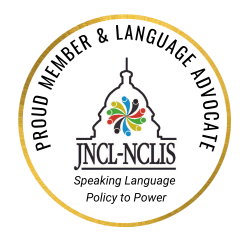|
For the last few months, SCFLTA has invited you to get to know your SCFLTA board. This month SCFLTA would like to introduce you board members Julia Royall, and Clay Hendrix! 1: What is your name?
My name is Clay Hendrix. 2:What level and language/s do/did you teach? I teach German 1-5 and International Baccalaureate in the 9th-12th grades. 3: What made you want to be a language teacher? I initially wanted to be a history teacher, but at university I really got inspired and wanted to learn German. After I graduated, I chose to do my MAT in German out of both convenience and a passion for German, but ended up very excited with language instruction and am glad I chose it over history (which I get to teach fun lessons for anyway!) 4: What has been the most rewarding part of your job? It's been really cool running into students after they've graduated high school who have been taking German in college. Several have done the same exchanges to Germany I did, lived in dorms my friends did, and taken classes abroad that I did. 5: What advice would you give to a new teacher? I think the most important part is to care about the students. Whatever else you're doing, they're what's important, they're what matters. 6: What do you think is the biggest challenge facing world language teachers today? It's difficult to say, because I think a lot of the struggle extends beyond our own corner to the profession as a whole. Personally I see a lot of antagonism towards teaching and schools in this country that is accelerating in a way that's worrisome to me as teacher shortages expand. I think this leads to the biggest problem facing us is a declining number of WL teachers, especially ones who have dedicated several years to gaining the unique skills to be a language instructor. Also as WL teachers leave the profession - some prematurely - we run the risk of losing hard fought for programs at schools state and nationwide. It's important then to do what we can to recruit new, younger teachers into the career from university programs, and provide support to those considering leaving, and perhaps resources for teachers in difficult or unsupportive schools to make lateral moves to nearby schools rather than into new careers. 7:How did you get involved with SCFLTA? I've been going to and presenting at SCFLTA conferences since I was in graduate school as far back as 2009. I eventually joined the board as a liaison from the board of the SC-AATG. 8: What role do you play in the organization? I am a liaison from the board of SC-AATG where I relay news back and forth between organizations. Over the years I've done help setting up conferences, and have also presented on occasion. 9: What has SCFLTA meant to you over your career? SCFLTA has given me ample opportunity for attending sessions to improve my instruction (one of my favorite activities I use in class I got from a session I attended in 2009) and meeting with and coordinating with other language instructors. I've either met new people to work with, or been able to see old colleagues and friends again after long times apart. 10: What do you see SCFLTA doing for the profession in the future? I think SCFLTA will always serve a role of helping integrate and assist new teachers into the culture, and offer teachers young and old new ideas for language instruction based on new research or even new creative activities conjured up by instructors willing to share their unique skills. 11:What is one non-teaching related fact about you? There's so much I can write that it's difficult to keep it to one thing. Right now my daughter is 3, and I really enjoy spending time with and taking care of her.
0 Comments
For the last few months, SCFLTA has invited you to get to know your SCFLTA board. This month, SCFLTA would like to introduce you board members Julia Royall, and Clay Hendrix!  1. What is your name? Julia Royall 2. What level and language/s do/did you teach? French 1, French 2, French 3&4 Honors 3. What made you want to be a language teacher? I struggled in school until the day my French teacher told me that I was good at French. From that moment on, I developed confidence in French, but also became more confident in all of my classes. Thanks to her and other teachers who supported me, I recognized a need for all children to have teachers who find their strengths and advocate for them. I developed a great love for French and Francophone cultures, and knew that being a French teacher would be not only enjoyable, but a way to be an advocate and support for children. 4. What has been the most rewarding part of your job? The most rewarding part of my job as a French teacher is having the opportunity to see students recognize that they can learn another language and develop enthusiasm about communicating with people from other cultures. 5. What advice would you give to a new teacher? First and foremost, enjoy your students. Learn from them. Consider every class an opportunity to learn. You may struggle and there may be tough days, but it will get better. Join professional organizations, and seek ideas and assistance from veteran teachers. Your colleagues are your greatest resource as a new teacher. 6. What do you think is the biggest challenge facing world language teachers today? Today, we have students in our classroom who have had a wide range of personal and educational experiences over the past few years. What we have always done to reach our students may not work anymore. More than ever before, we are needing to differentiate instruction and adapt our lesson plans to meet the needs of our students. 7. How did you get involved with SCFLTA? I became involved in 2020 as a Regional Representative for the Lowcountry. 8. What role do you play in the organization? I currently serve as an Affiliate Representative for the AATF (American Association of Teachers of French). 9. What has SCFLTA meant to you over your career? SCFLTA has been a great help to me since I moved back to South Carolina in 2010. The conferences have provided meaningful professional development that has greatly helped my teaching practice. In addition, I have been able to meet colleagues across the state who are now friends, and also people with whom I an collaborate. 10. What do you see SCFLTA doing for the profession in the future? I think SCFLTA will continue to be a valuable resource for the World Language teachers of South Carolina. We have a talented group of members who are always willing to help other teachers in our state and beyond. 11. What is one non-teaching related fact about you? I have been a Big Sister in the Big Brothers Big Sisters program for the last 5 years, and my little sister recently graduated high school and is now in the military!  For the next few months, get to know your SCFLTA board. Each month we will introduce board members! This month, SCFLTA would like to introduce you to Dr. Rocio Zalba and Cristain Ugro! What is your name? Cristian Ugro What level and language/s do/did you teach? I currently teach Latin 1-AP and Ancient Greek. In the past, I have also taught French. What made you want to be a language teacher? I grew up in communist Romania, where access to information about the outside world was strictly limited and censored. Learning other languages was the only way I could learn about other places, so my first reason was practical. Little by little, that turned into a love for languages, for how they function, and for how they broaden one’s horizon. Lastly, once I realized I was reasonably competent in several languages, it seemed like a pity not to share that with young people. What has been the most rewarding part of your job? Without a doubt, spending time with my students: they keep my on my toes, and they provide endless opportunities for amusement. What advice would you give to a new teacher? To stick with it: teaching is as much a vocation as it is a skill. The more you learn the tools of the trade, the easier and more rewarding it becomes. What do you think is the biggest challenge facing world language teachers today? One challenge that is not limited to world language teachers is dealing with the effects of the most recent pandemic. One specific to world language teachers is that many districts, although thankfully not all, do not value world language teaching beyond token statements and actions, and lack an overarching vision for the advancement of the teaching, and benefits thereof, of languages. How did you get involved with SCFLTA? I learned about SCFLTA when I attended a conference in the early 2000s. Since then, I became more involved and eventually became part of the board in 2012. What role do you play in the organization? I am a member of the board by virtue of being the president of the SC Classical Association. What has SCFLTA meant to you over your career? SCFLTA, more specifically its meetings and conferences, has allowed me to meet and become friends with like-minded teachers from across the state. It has been a very rewarding experience, and I recommend it to all language teachers in the state. What do you see SCFLTA doing for the profession in the future? SCFLTA will continue to advocate for world-language-related initiatives across the state, and to represent SC on the regional and national level. What is one non-teaching related fact about you? My love of, and relative competency in, languages has allowed me to live and work (well, teach, so not quite non-teaching related) in three countries other than my native one. 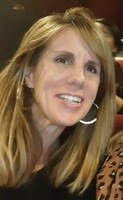 For the next few months, get to know your SCFLTA board. Each month we will introduce board members! This month, SCFLTA would like to introduce you to Dr. Rocio Zalba and Cristain Ugro! What is your name? Rocio Zalba What level and language/s do/did you teach? For 23 years, I taught all levels of Spanish. From novice, low to advance low, from literature and culture to film and theater. What made you want to be a language teacher? In my sophomore year of College, my Spanish Lit professor asked if I could substitute a TA (Teaching Assistant) they hired to teach a lower-level Spanish course. The TA had left, and they had no one. I had never taught before (& certainly not my peers), but I agreed. I was given a textbook, classroom location and sent on my way. Fortunately for them but most fortunately for me, I loved it. I found my calling and have been teaching languages ever since. What has been the most rewarding part of your job? In the classroom, the most rewarding part of my job was seeing the students put aside their apprehensions and fears and engage with the language and culture. That first step they take towards communicating in the target language always fills me up. In my current role at the State Department of Education is hearing the passion and commitment of our world language teachers and seeing all of the creative initiatives implemented in our WL classrooms. I am in a constant state of admiration, respect, and appreciation. What advice would you give to a new teacher? Progress, not Perfection. And step into another teacher's classroom. Observing other phenomenal teachers is powerful. What do you think is the biggest challenge facing world language teachers today? The biggest challenges seems to be the same today as yesterday: having the acquisition of a second language be recognized by stakeholders as a valuable asset in our student's education. I think all WL teachers carry an invisible pin that says, "WL teacher/ Advocate for Languages." How did you get involved with SCFLTA? I first got involved as a participant by attending the annual conference, then as a presenter, and now I am on the board. What role do you play in the organization? I am part of the Executive Committee and support the Director and President in all their initiatives. What has SCFLTA meant to you over your career? SCFLTA has provided me with a community of educators that, like me, are passionate about second language acquisition. What do you see SCFLTA doing for the profession in the future? Continue to provide a safe and welcoming space for all language teachers where they can receive the support and resources they need to continue growing in their profession. What is one non-teaching related fact about you? I was born and raised in Argentina, but my family moved to Canada when I was 12. I am also a proud Canadian. The Celebration of National Hispanic Heritage Month was not lost on Richland School District Two; on Thursday, October 6th, several elementary, middle and high schools throughout the district made presentations that represented many of the Spanish speaking nations of the world in “Parade of Nations”.
How have you and your students, schools, and communities been celebrating National Hispanic Heritage Month? Submitted by Nadine Okoduwa Stewart, SCFLTA President 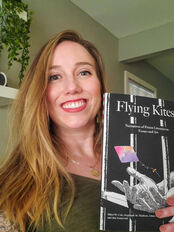 For the next few months, get to know your SCFLTA board. Each month we will introduce board members! This month, SCFLTA would like to introduce you to Dr. Jeremy Patterson and Dr. Stephanie Madison! What level and language/s do/did you teach? I taught high school Spanish for ten years. Now I work in Clemson University College of Education as a project manager and adjunct faculty in the Literacy, Language, and Culture program. What made you want to be a language teacher? I thought I wanted to be a medical interpreter and got my teaching license as a backup plan. Well, turns out my backup plan became my passion, and I am thrilled to continue working in education! What has been the most rewarding part of your job? I always say that if we take care of our teachers, they will take care of our students. In my role as a project manager and as adjunct faculty, I work with teachers across South Carolina every day. Hearing stories of success is the very best part. What advice would you give to a new teacher? My advice to a new teacher would be to find your teacher friends and support network. Mentors are the unsung heroes of the profession. These people are your greatest source of information, guidance, and feedback, especially with difficult situations. What do you think is the biggest challenge facing world language teachers today? The biggest challenge facing world language teachers is finding joy when the public education conversation remains negative. I think world language classrooms are unique spaces for students to learn through interaction with others, fostering human connection that has been lacking in recent years. These are spaces that center humanity. When people outside of education go to social media to rant and rave about public education, I always suggest they sign up to be a substitute teacher to be part of the solution. We know that teachers continue to provide a warm, kind, and inviting space for students, no matter what anyone else is saying. How did you get involved with SCFLTA? I got involved in SCFLTA a few years into my teaching career. I had been teaching in North Carolina and was involved with FLANC, so when I moved back to South Carolina, I was excited to work with another organization. What role do you play in the organization? I am the SCFLTA Upstate Representative. Being at Clemson, I travel around the Upstate area quite a bit. My goal is to encourage teachers to attend SCFLTA conferences and get involved with a supportive community of language teachers. What has SCFLTA meant to you over your career? SCFLTA has impacted my life in so many ways! For example, when I was working on a research project, I had friends I could call to get input and ask to be participants. Connections are everything and having a network of support makes all the difference. What do you see SCFLTA doing for the profession in the future? I hope SCFLTA continues to work with SC universities to recruit new world language teachers out of high school in addition to being the focal point of the SC world language community. Even if we only see our teacher friends from across the state once a year at SCFLTA or SCOLT or ACTFL, these are life-long friends and time together is so impactful. What is one non-teaching related fact about you? I have a new co-edited book out! It is called Flying Kites: Narratives of Prison Literacies in Essays and Art. I worked with a colleague on a chapter about literacies in immigrant detention centers, a space in which educational services could be transformational.  For the next few months, get to know your SCFLTA board. Each month we will introduce board members! This month, SCFLTA would like to introduce you to Dr. Jeremy Patterson and Dr. Stephanie Madison! What level and language/s do/did you teach? All levels of French and Spanish at Bob Jones University What made you want to be a language teacher? To help people understand other people and cultures What has been the most rewarding part of your job? Actually observing students advance from one level of proficiency to the next What advice would you give to a new teacher? Be yourself in the classroom! What do you think is the biggest challenge facing world language teachers today? Monocultural viewpoints How did you get involved with SCFLTA? Attending the annual conference What role do you play in the organization? Social media director What has SCFLTA meant to you over your career? Networking at the local level – longer and closer relationships than at the national level What do you see SCFLTA doing for the profession in the future? Continuing to develop professional relationships within our state What is one non-teaching related fact about you? I cannot blow bubbles with bubblegum. You can try to teach me, but I don’t think it will work… For the next few months, get to know your SCFLTA board. Each month we will introduce board members! This month, we begin with Dr. Jason Bagley-Cooler, SCFLTA Executive Director and Xiaolin (Rebecca) Feng, the SCFLTA 2022 World Language Teacher of the Year. 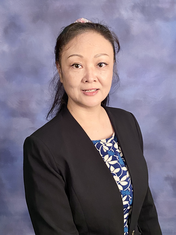 Xiaolin (Rebecca) Feng What level and language/s do/did you teach? I'm a high school Chinese Teacher. I teach all levels of Chinese from regular classes Level 1-5HN to Immersion classes Level 3-5; and AP Chinese. What made you want to be a language teacher? When I was little, I was very good at singing, and was selected to a regional choir group. I sometimes performed as a solo in the group. My choir teacher told me there were usually direct and positive connections for people who sing well and speak beautifully a foreign language. I believed her and became a language teacher without much struggle. What has been the most rewarding part of your job? Having been a language teacher for more than 20 years, the most rewarding part is to see students acquire cultural competence and global view through the language learning process, on top of beautiful pronunciation. What advice would you give to a new teacher? My advice for a new teacher is first love your job and be ready for challenges, second, always learn from experienced teachers and your own experiences. What do you think is the biggest challenge facing world language teachers today? The biggest challenges we face today is the technology and globalization that impact the traditional ways of teaching and learning. Students rely on answers from translation apps. overlooking contexts and cultural nuances. Globalization tries to bring the world together but also creates barriers among countries and industries. How did you get involved with SCFLTA? SCFLTA is the hub linking me with other WL professionals; Empowering and encouraging me when facing challenges. What role do you play in the organization? As 2022 Teacher of the Year, I'm honored and thrilled serving as a board member in the organization. What is one non-teaching related fact about you? I've also been in several other professions at the same time being a teacher, such as I once worked in media stations for years. I'm eager for the opportunity of making my contribution to advocate for SCFLTA. For the next few months, get to know your SCFLTA board. Each month we will introduce board members! This month, we begin with Dr. Jason Bagley-Cooler, SCFLTA Executive Director and Xiaolin (Rebecca) Feng, the SCFLTA 2022 World Language Teacher of the Year.  Dr. Jason Bagley-Cooler What level and language/s do/did you teach? I teach high school French, levels 1-5. What made you want to be a language teacher? Actually, I didn't start out to even teach! Thanks to my high school French teacher, I wanted to do something with French, and I wanted to go to Clemson. I thought I wanted to do international business until I took economics in high school and realized that that was not the field for me. Education was what I decided to try after I gave up on business. What has been the most rewarding part of your job? I think most people would agree that it's super rewarding when you have students who get in touch with you after they've graduated or finished with your class and have had an experience with another culture or have decided to continue studying language. That is always a great feeling! What advice would you give to a new teacher? Take time for self-care. This has become increasingly important over the past few years, and is so important! You can't serve from an empty glass! What do you think is the biggest challenge facing world language teachers today? I think that across the board that a shortage of teachers is a crisis. The teaching profession is not as attractive to many young people these days, and I think it's something that we all have to strive to change. How did you get involved with SCFLTA? My first interaction was actually when I was working on my MA, and part of our course work was to give a presentation session at the annual conference! Then I was asked to be the SCFLTA webmaster and editor of The Crescent newsletter. Here we are 16 years later! What role do you play in the organization? Currently I serve as the Executive Director. What has SCFLTA meant to you over your career? SCFLTA has been wonderful. I actually left the teaching profession for two years because I felt that I was losing my passion and language ability. I didn't know as a young teacher about professional organizations and the connections and friendships that result from participation. SCFLTA helped my return to teaching be much more fulfilling, professionally. What do you see SCFLTA doing for the profession in the future? I'd love to see more participation, of course. We have tried to get some initiatives going for collaboration and community building, but there hasn't always been great participation. What is one non-teaching related fact about you? I got married last year and married life has been great! I also do yoga about 6 days a week. Carver-Lyon Elementary School went all out to celebrate the Chinese Lunar New Year 2022, the Year of Tiger.
Not only did they decorate their school for this even, but all Chinese language immersion students received red envelopes ( 红包) with good luck coins, and all Chinese immersion teachers and partner teachers received good luck necklaces of Chinese traditional values and tiger. The following Chinese immersion grade levels celebrated by: PreK students made the Great Wall with wooden blocks. K students did Chinese calligraphy with team work to write "福"(blessing) and "春联“ Spring Couplet) and then decorated them on the door. 1st Grade students did Chinese dance with traditional song. 2nd Grade students sang a Chinese song. 3rd Grade students did a paper cutting of the tiger and panda. 4th Grade students did paper cutting of the Spring Festival couplets. 5th Grade students paid New Year visit with dragon dance to all the classes at school. Thank you, Carver-Lyon, for sharing your creativity with us. |
Editor of
|
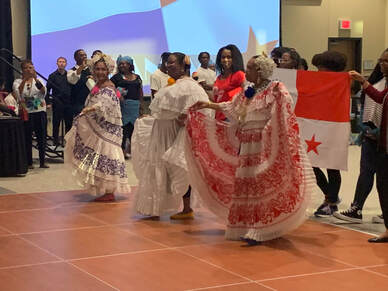
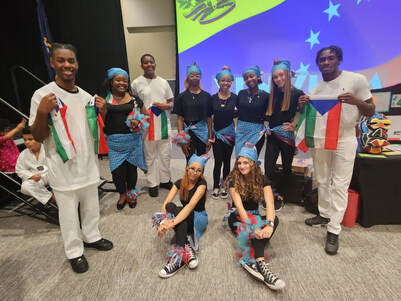
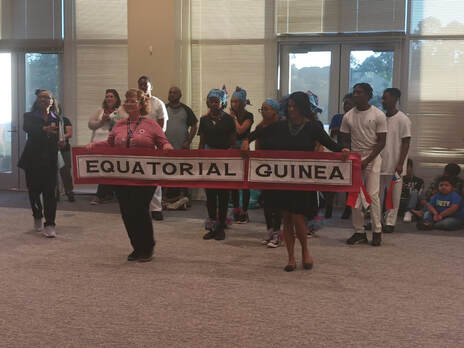
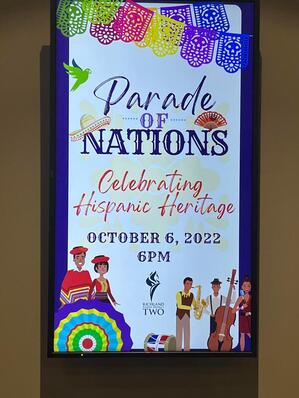
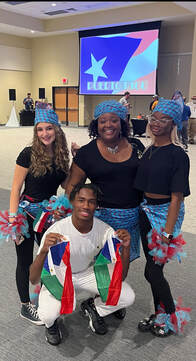
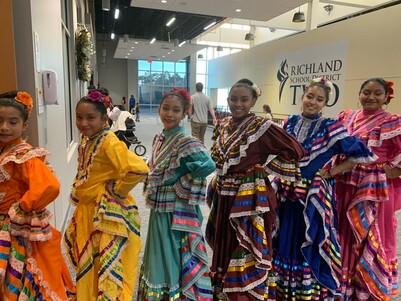
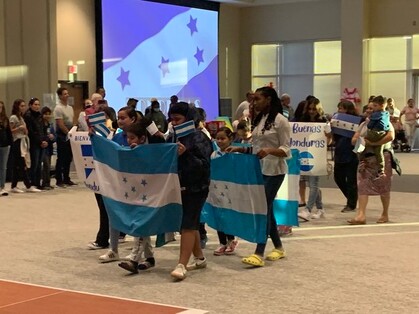
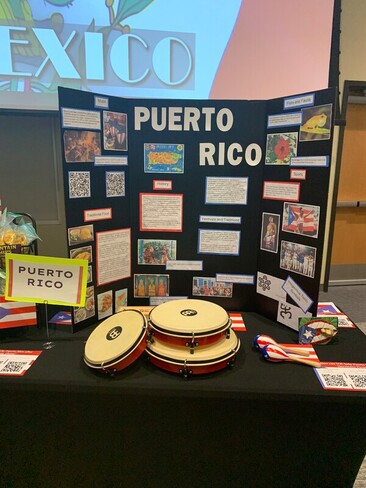
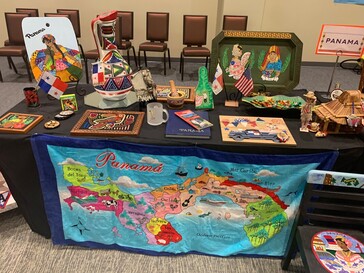
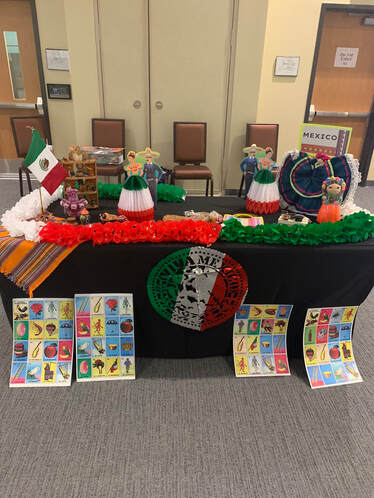

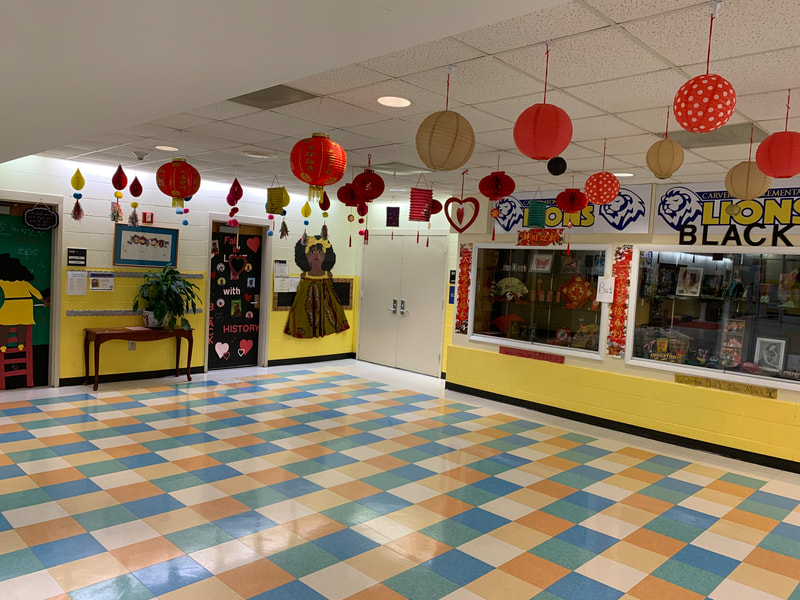
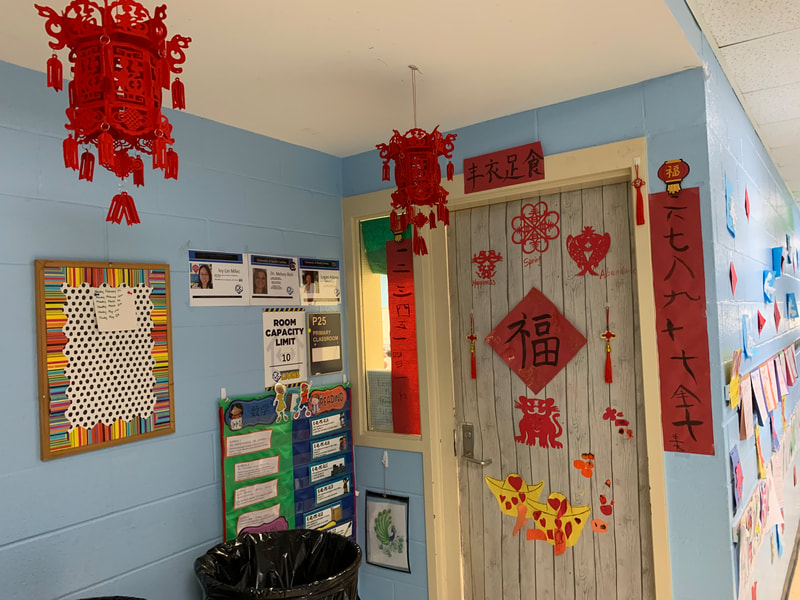
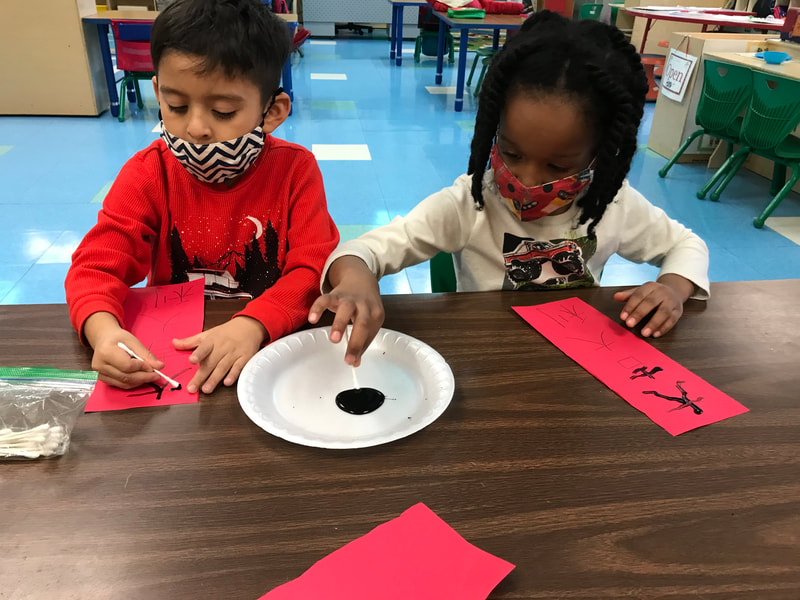
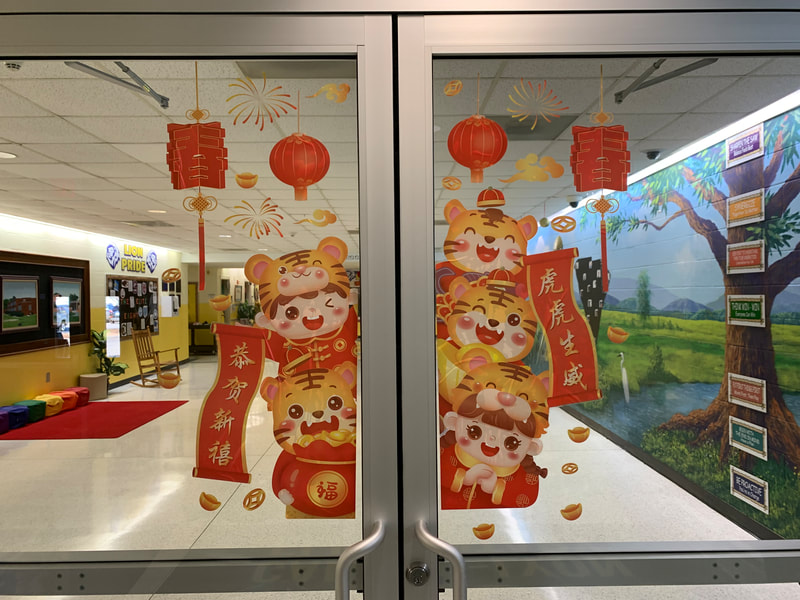
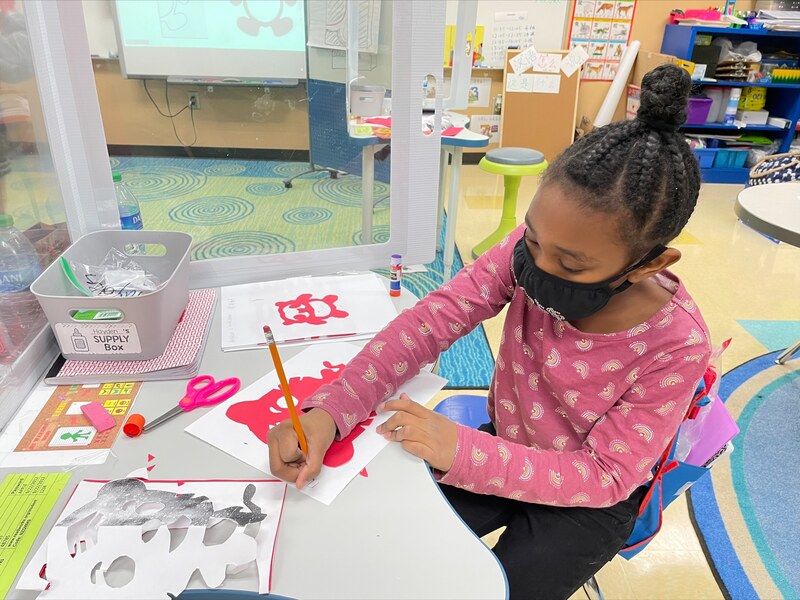
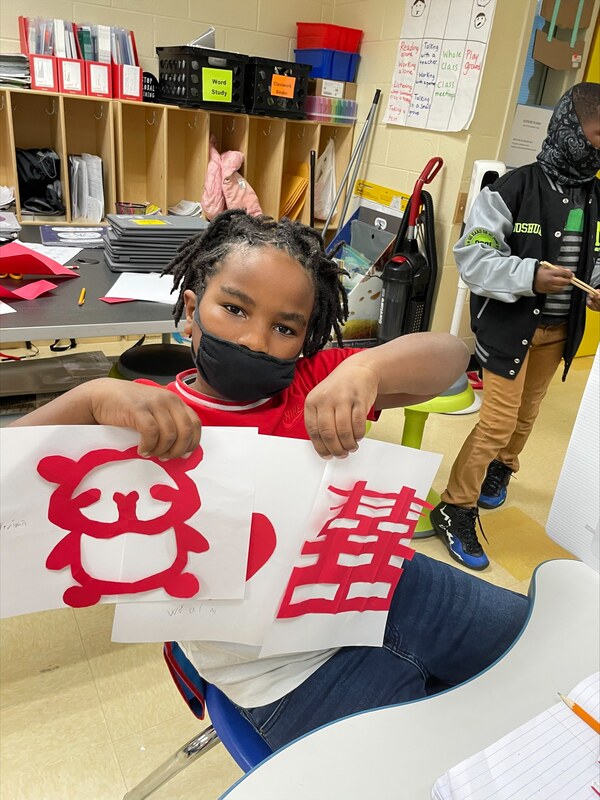
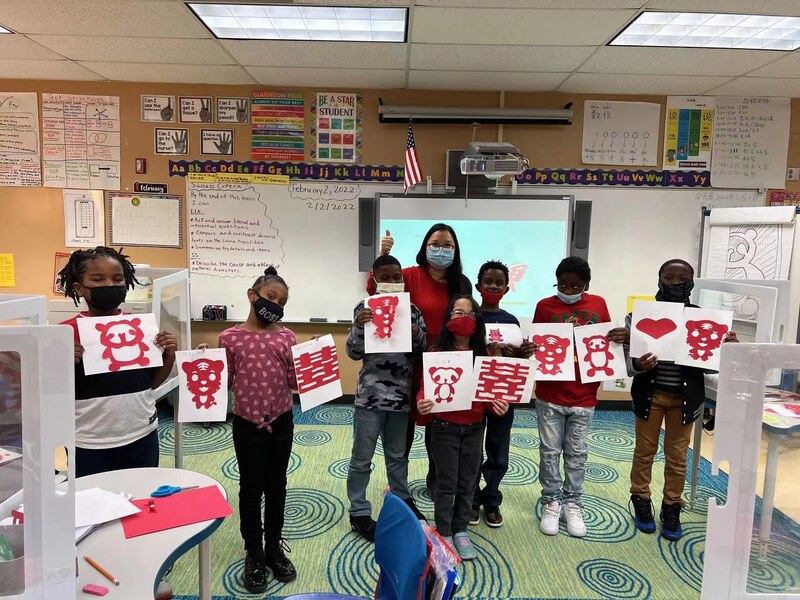
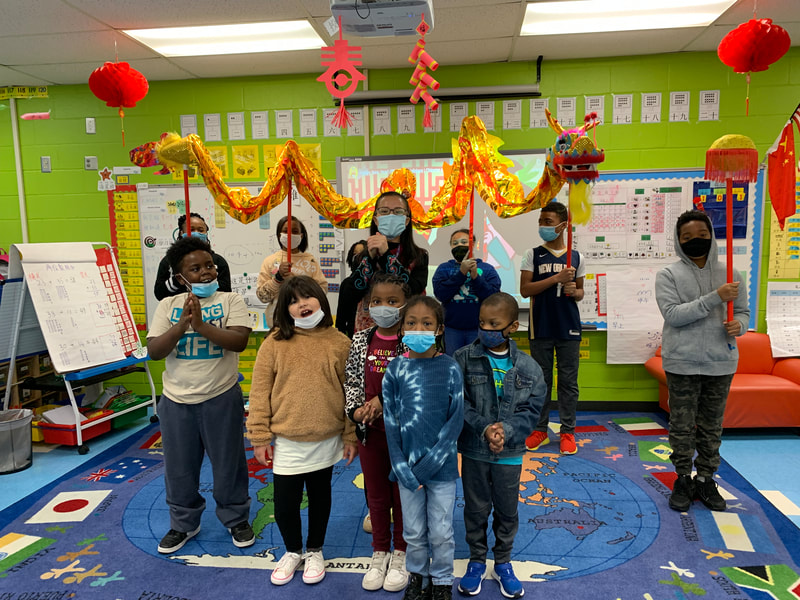

 RSS Feed
RSS Feed
